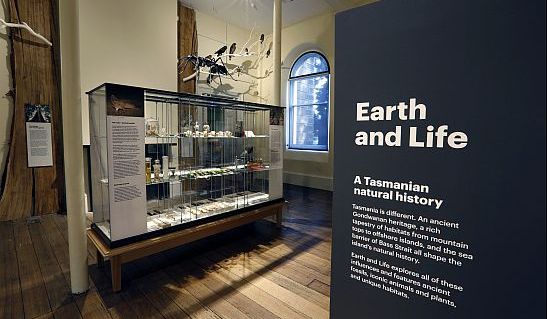Exhibits

Zoology Unit staff conduct research and determine the themes and content of natural history exhibitions throughout the Tasmanian Museum and Art Gallery (TMAG). They aim to ensure that Tasmanian fauna is represented realistically and that all text information is up to date and scientifically accurate. Staff select and prepare specimens for display, write text and labels and, with conservation, registration and exhibitions staff, are also responsible for their installation and ongoing maintenance.
Zoology Unit staff have curated three permanent exhibitions at TMAG and have assisted other curators with the inclusion of zoological material as required.
One of their main contributions to the museum’s exhibits is to the Earth and Life gallery. This gallery showcases some of the many aspects of Tasmania’s natural history that make the island special. The overarching philosophy has been to present displays that, wherever possible, integrate rather than segregate the scientific disciplines of zoology, botany and geology. After all, Tasmania is a living, evolving entity that is much more complex than the sum of its individual plants, animals and rocks.
In keeping with this philosophy, the exhibits aim to help visitors develop a stronger appreciation of the contributions of ecology, evolution, climate, landforms and geological processes to the nature of present-day Tasmania, both on land and in the surrounding seas. The choice of labelling and layout also gives visitors an insight into the importance of museums as repositories for species-based collections and as active hubs of taxonomy-based and collections-based research.
There are individual display cases dedicated to iconic Tasmanian mammals, such as the wallaby, pademelon, echidna, platypus, devil and quoll. The gallery also introduces visitors to many other species of which they might be unaware, yet also help to define Tasmania – including birds, fish, insects, spiders, crustaceans, seashells, kelp, lichens and a range of rainforest, buttongrass and alpine plants.
Tasmania’s long and eventful geological history provides the backbone to understanding much of the natural world that exists in Tasmania today, as well as Tasmania’s rich mineralogical heritage. The break-up of the supercontinent of Gondwana, Tasmania’s gradual drift northwards, and the Pleistocene Ice Ages have all left their mark. The ‘rock wall’ at one end of the gallery aims to help explain how Tasmania’s geological history has influenced today’s landforms, whilst adjacent displays help draw links between geology, time, evolution and ecology.
At the other end of the gallery, the chimney-brickwork and fireplace have been bookended by two floor-to-ceiling radial cross-sections of an old-growth Eucalyptus delegatensis tree, one of Tasmania’s iconic ‘forest giants’. Old trees and the logs that arise from them are important homes for a vast range of dependent species. In this exhibit, the fireplace, representing the giant tree’s hollow butt, houses bats and huntsman spiders, while forest birds perch on branches anchored to the wall and bark-inhabiting lichens and log-inhabiting beetles feature in the adjacent display case.
Taking centre stage in the gallery is an exhibit of buttongrass moorland, an almost uniquely Tasmanian habitat, while immediately adjacent is a living colony of jackjumper ants, Tasmania’s most dangerous animal. These two exhibits incorporate various interactive features, and are the location for most of the gallery’s interpretative activities. Younger visitors can further explore the gallery through footprints on the floor connecting extant species of mammals to their extinct relatives, and rummage through the drawers in the shell cabinet.

